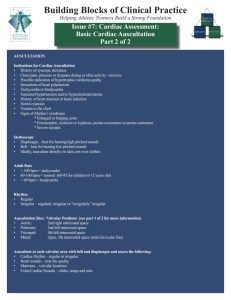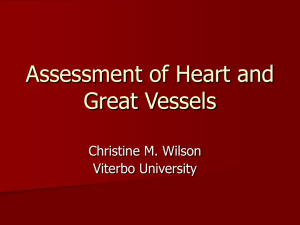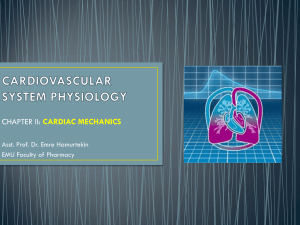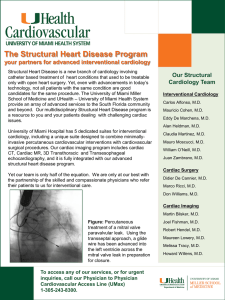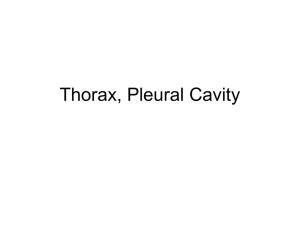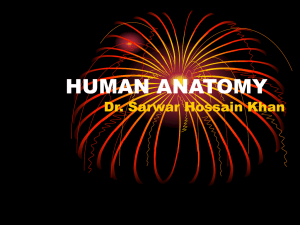Cardiovascular System
advertisement
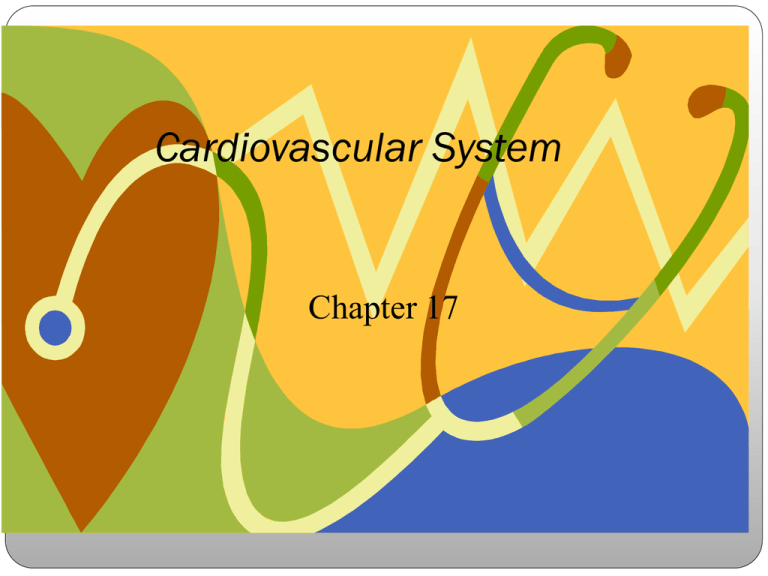
Cardiovascular System Chapter 17 Cardiovascular System Cardiovascular System – circulates blood continuously thought the body to deliver oxygen and nutrients to the body’s organs and tissue and to dispose of waste. Heart (pump) and vasculature (plumbing) The heart is composed of: Cardiac muscle Atria Ventricles Valves Cardiac arteries and veins Electrical conduction system Cardiac Nerves Problems or failure of any of these system can lead to serious health concerns. Review Anatomy Figure 17.3 Structural components of the heart. Heart Heart – pump composed of synchronized structures Cardiac Vessels Coronary Arteries – extensive network of arteries supplying the heart Coronary Veins – network for venous blood drainage Conduction system – heart has it own conduction system which can initiate and transmit an electrical impulse via cardiac muscle fibers This electrical charge stimulates muscular contraction of the heart SA node, AV node, Bundle of His, Right and Left Bundle Branch Block, and Purkinje fibers Nerves Sympathetic – stimulate the heart, increases heart rate, force of contraction, and dilation of coronary arteries. Parasympathetic – opposite effect CNS – influences the activation and interaction of nerves through information supplies by the cardiac plexus. Cardiac Musculature Heart Muscle Base Apex – point of maximum impulse so heart beat is more easily palpated over the apex – 5th intercostal space Three Layers: Epicardium – outer layer Myocardium – thick muscular layer Endocardium - smooth inner lining of chambers Chambers Chambers in the Heart – 4 chambers Left and right atria – receiving chambers for blood and pump blood into the ventricles Left and right ventricles – eject blood into vessels Valves Valves - Permit the Flow of Blood Between Chambers and into Blood Vessels Atrioventricular (AV) Tricuspid Mitral Semilunar Pulmonary Aortic Heart Sounds Heart Sounds – Closure of valves which are associated with the contraction and relaxation phases of the heart. Systole – refers to ventricular contraction and begins with closure of the AV valves (S1) and ends with the closure of the aortic and pulmonic valve (S2) Diastole – refers to ventricular relaxation and begins with closure of the aortic and pulmonic valve (S2) and ends with closure of AV valves (S1). S1 (lub) S2 (dub) Figure 17.5 Heart sounds in systole and diastole. Table 17.3 Distinguishing Heart Murmurs Table 17.3 (continued) Distinguishing Heart Murmurs Table 17.4 (continued) Classifications of Heart Murmurs Circulation of Heart Pulmonary Circulation – carries deoxygenated blood to the lungs, where carbon dioxide is exchanged for oxygen. Systemic Circulation – supplies freshly oxygenated blood to the body’s periphery carrying oxygen and nutrients to cells. Electrocardiogram Electrocardiogram (EKG) - Paper Recording of Deflections That Represent the Cardiac Cycle – Signifies electrical conduction Electrical deflections P wave PR interval QRS interval T wave Figure 17.11 Electrocardiogram wave. Cardiac Function Stroke volume - Amount of blood that is ejected with each heartbeat Cardiac output - Amount of blood ejected from the left ventricle over one minute Cardiac index - Measurement accounting for an individual’s weight when evaluating the pumping action of the heart Landmarks for Cardiac Assessment Landmarks for Cardiac Assessment Sternum Clavicles Ribs Second through fifth intercostal spaces Correlating assessment findings over body landmarks provides vital information related to underlying pathologic mechanisms. Figure 17.18 Landmarks in precordial assessments. Inteview General Questions Specific Questions Illness Symptoms Behaviors Infants and children Pregnant female Older adult Environment Equipment Examination gown Examination drape Stethoscope Metric rulers Doppler Techniques Physical Assessment of the Cardiovascular System Techniques Inspection Palpation Percussion Auscultation Specific Areas Specific Areas of the Cardiovascular Assessment Inspection of the face, lips, ears, and scalp Skin color Movement Earlobe creases Inspection of the jugular veins Pulsations Distention Inspection of the carotid arteries Pulse characteristics Inspection of the hands and fingers Color Shape of fingers Figure 17.17 Splinter hemorrhage. Specific Areas Inspection of the chest, abdomen, legs, and skeletal structure Landmarks Right sternal border, 2nd intercostal space Left sternal border, 2nd intercostal space Left sternal border, 3rd – 5th intercostal space Heaves and lifts Palpation Palpation of the chest, including the following Precordium at the right and left second intercostal spaces Left third intercostal space Left fourth intercostal space Left fifth intercostal space at the midclavicular line Position patient at a 30 degree angle or less No thrills, heaves or lifts should be palpated in any of the five locations Figure 17.19 Landmarks for palpation of the chest. Palpation Carotid pulses (sequentially) Client may be supine or sitting upright Asses: Presence – diminished or absent may indicate carotid disease or dissecting aortic aneurysm Strength – should be strong but not bounding Rhythm – regular pattern Equality – consistent bilaterally Palpate each artery separately – may obstruct blood flow to the brain, resulting in severe bradycardia or asystole Figure 17.20 Palpating the carotid artery. Percussion Percussion of the chest for cardiac border 5th intercostal space at the left anterior axillary line Normal findings would be resonance because you will be over lung tissue Next, percuss the mid clavicular line and the left sternal border Should change to dull as you percuss over the heart Advance to the 3rd and 2nd intercostal space on the left side. Should change from resonnance to dullness as you percuss over the heart Figure 17.21 Percussing the chest. Auscultation Auscultation of the chest using the diaphragm and bell in various positions to include the following locations Aortic area at the right second intercostal space—S2 is louder than S1 Pulmonic area at the left second intercostal space—S2 is louder than S1 Erb’s point at the left third intercostal space—S1 and S2 are heard equally Tricuspid area at the left fourth intercostal space—S1 is louder than S2 Apex at the left fifth intercostal space at the midclavicular line—S1 is louder than S2 Figure 17.22 Auscultating the chest over five key landmarks. Figure 17.24A Positions for auscultation of the heart. A. Supine. Figure 17.24B Positions for auscultation of the heart. B. Lateral Figure 17.24C Positions for auscultation of the heart. C. Sitting. Auscultation of Apical Pulse Specific Areas of the Cardiovascular Assessment Auscultation of the carotid arteries using the diaphragm and bell Comparison of the apical pulse to a carotid pulse Figure 17.23 Comparing the carotid and apical pulses. Abnormal Findings Abnormal Findings in the Cardiovascular System Myocardial and pump disorders Valvular disease Septal defects Congenital heart disease Electrical rhythm disturbances Muscular and Pump Disorders Myocardial and Pump Disorders Myocardial ischemia Myocardial infarction Congestive heart disease Ventricular hypertrophy Valvular Disorders Valvular Diseases Mitral, aortic, tricuspid, and pulmonic stenosis Mitral and aortic regurgitation Mitral valve prolapse Figure 17.25 Mitral stenosis. Figure 17.26 Aortic stenosis. Figure 17.27 Mitral regurgitation. Figure 17.28 Pulmonic stenosis. Figure 17.29 Tricuspid stenosis. Figure 17.30 Mitral valve prolapse. Figure 17.31 Aortic regurgitation. Setal Defects Septal Defects Openings between the right and left atria or right and left ventricles Figure 17.32 Ventricular septal defect. Figure 17.33 Atrial septal defect. Congenital Heart Diseases Congenital Heart Diseases Coarctation of the aorta Patent ductus arteriosus Tetralogy of Fallot Figure 17.34 Coarctation of the aorta. Figure 17.35 Patent ductus arteriosus. Figure 17.36 Tetralogy of Fallot. Figure 17.36 (continued) Tetralogy of Fallot. Rhythm Disturbances Electrical Rhythm Disturbances Ventricular tachycardia Ventricular fibrillation Figure 17.37 Ventricle tachycardia. Figure 17.38 Ventricular fibrillation. Figure 17.39 Heart block. Figure 17.40 Atrial flutter. Figure 17.41 Atrial fibrillation. Developmental Considerations Pediatric Fetus receives oxygen and nutrients from the mother Changes occur in the newborn’s cardiovascular system Infant’s heart rate Developmental Considerations Pregnant Female Heart is displaced to the left and upward Blood volume increases 30 to 50 percent Cardiac output and stroke volume increase Resting pulse may increase Murmurs may be auscultated Developmental Considerations Geriatric Loss of ventricular compliance and vascular rigidity Conduction system loses automaticity Psychosocial Considerations Stress and workload of the heart Considerations Race Ethnicity Diet Substance abuse Healthy People 2010 Focus Areas Outlined in the Healthy People 2010 Coronary heart disease High blood cholesterol Healthy People 2010 Key Objectives for Coronary Heart Disease Reduce deaths Increase awareness of symptoms of heart attack and the need for rapid emergency care Increase the numbers of adults who can administer cardiopulmonary resuscitation Reduce the number of obese individuals Increase physical activity Increase the number of adults who are aware of risk factors and take action to reduce risks Healthy People 2010 Key Objectives for High Blood Cholesterol Reduce the number of adults with elevated cholesterol levels Increase the number of adults who have cholesterol levels measured
